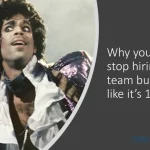
Simon Sinek says, “You don’t hire for skills, you hire for attitude. You can always teach skills.” – Not only does this sound good, but hiring for attitude increases job satisfaction for both employees and employers. And that is good for everyone and the bottom line.
The average employee job dissatisfaction rate is more than 50%. About 80% of employees are dissatisfied, specifically with the relationship with their direct line manager. This high level of dissatisfaction results in a difficult work environment, a high turnover rate, and a dramatically negative impact on an organization’s bottom line.
So, what is the source of job dissatisfaction, and how can it be resolved or at least mitigated?
Exposing our inner geek, we decided to look at the issue from both the perspective of the employee (”the individual”) and the employer (“the manager”)—rationale: if there are so many dissatisfied employees, there must be an equally great number of dissatisfied employers. Understanding the issue from both sides and understanding when reasonable action can be taken to improve the situation (and when it cannot), we came to grasp why hiring for attitude and assessing compatibility in the hiring process is the best place to increase job satisfaction.
To begin with, all positions, with and without management responsibilities, have three types of characteristics:
1) Job characteristics: The job that needs to get done—including things like the variety of skills needed to get the job done, the significance of the task to the team and organizational result, the extent of autonomy of the work at hand, and the nature of feedback received from the direct supervisor as well as internal and/or external clients.
For positions with people-management responsibility, job characteristics also include things like the management tasks involved, the dependency of the manager on the direct reports/employees to deliver an outcome, as well as the feedback the manager receives on the performance of their contribution and the contributions of the individuals reporting to them.
2) Organizational characteristics: The attitude of people in the environment, including the attitude of the coworkers around the individual towards their work, the manager, the other people in the organization, and the clients.
For positions with people-management responsibility, the organizational characteristics also include the attitudes of the direct reports.
3) Individual/personal characteristics: The predisposition of the person doing the job, including the predisposition of an individual towards things and situations in general, whether someone is a “glass half full” or “glass half empty” kind of person.
For positions with people-management responsibility, this includes the attitude of the manager towards the individuals reporting to him.
Together, these three position characteristics impact the person (the individual and the manager) on an emotional, cognitive, and behavioral level. That is, they impact how an individual feels, thinks, and reacts to their position and how a manager feels, thinks, and reacts to their position and their employees, resulting in the overall attitude towards the position, or the case of a manager, resulting in the overall attitude towards the position and their employees.
This attitude can be expressed in one of two ways: 1) Global Satisfaction/Dissatisfaction or 2) Facet Satisfaction/Dissatisfaction.
So then the question is: does being able to identify and measure an issue mean that it is actionable and improvable?
Well, whether an issue is resolvable or unresolvable depends on the nature of the issue.
The nature of all issues can be related to one of the three position characteristics: job characteristics (the job that needs to get done), organizational characteristics (the attitude of people in the environment), and individual/personal characteristics (the predisposition of the person doing the job).
If an issue is related to the job characteristics, it is likely to be negotiable and actionable and therefore improvable and even resolvable. This is the area where individuals, managers, and human resources can make strides in understanding the issues related to dissatisfaction and develop and negotiate appropriate action plans to improve or resolve issues.
However, in cases where the issues are related to organizational characteristics and individual/personal characteristics—while there are short-term band-aid solutions, such as teambuilding events, finding a space for open dialogue, and so forth, which are all good in theory—in practice, these issues are most often under what could be called “irreconcilable differences” for both parties.
Therefore, to increase job satisfaction, the best thing an employer and an employee can do is include compatibility as part of the selection criteria early in the hiring process. And, we believe, this is why when Simon Sinek says, “You don’t hire for skills, you hire for attitude. You can always teach skills.” It resonates deeply with so many people who know this very well from their own experience as an employer and an employee.
Have a question? Find answers in our FAQ!

Connection is THE Prerequisite for Team Success Minal Joshi Jaeckli July 20, 2025 Think of your favourite manager and answer the following two questions.What did.

What do YOU need to address in your organization: JOB FIT or INTERPERSONAL FIT? Minal Joshi Jaeckli July 19, 2025 Do you feel that the.

Why You Should Stop Hiring and Team Building in Hiring Process Like It’s 1999 Minal Joshi Jaeckli July 19, 2025 Description: Why? Because using the.